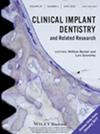A Multicenter Study of Factors Related to Early Implant Failures—Part 1: Implant Materials and Surgical Techniques
Abstract
Background
Dental implant materials, designs as well as general concepts for surgical techniques have evolved during the last decades. It has been validated that primary stability followed by bone apposition around implants is crucial for implant survival as most implant failures occur during the first year. However, new implant materials and different micro and macro designs have improved implant survival in more challenging clinical conditions. Therefore, clinical research with large patient groups is needed to investigate the effects of different implant designs and surgical protocols with the aim to improve early implant outcomes.
Purpose
The purpose of the study is to investigate the clinical use of dental implant materials, designs, and surgical techniques related to early implant complications and failures.
Materials and Methods
All patients who had received implant surgery in 2007 and 2017 at three specialist centers in Sweden were identified using charge codes. Data were retrieved from a dental record system as well as from digital and analog registries on implant surgeries. Information on anamnestic data, bone status, implant materials and designs, surgery techniques, and early implant failures and complications during the first year was compiled and analyzed. Descriptive statistics were used for comparison of the time cohorts. The data were statistically analyzed with a multivariable logistic regression model with a significance level of p < 0.05 using early implant failures and complications as the dependent variables.
Results
For 2007, 799 patients with 2473 implants were identified. For 2017, 1076 patients with 2287 implants were identified. However, 74 (3.7%) patients were excluded, mainly due to lack of data. Differences were observed when comparing the two cohorts. In 2017, fewer preoperative antibiotics were prescribed, more incidences of exposed implant threads were reported, more non-submerged implant surgeries were performed, shorter implant lengths were used, more implants were placed in augmented bone, and tapered implants with a variable design were used. Implants of commercially pure titanium (CP Ti) Grades 1–4 with moderately and minimally rough surfaces were used in 2007, whereas CP Ti Grade 4 and alloy titanium zirconium (TiZr) with moderately rough surfaces were used in 2017. Significantly higher number of implant failures were reported in 2017 at the implant level: 56 (2.4%) in 2017 compared to 26 (1.1%) in 2007. Eleven variables were shown to increase the risk of failure including exposed implant threads OR 3.56 (1.60, 7.91) p = 0.0018 and increased number of implants per patients 1.26 (1.14, 1.39) p < 0.001 analyzed at the patient level. Nine variables were shown to increase the risk of early implant complications, including exposed implant threads OR 4.52 (2.60, 7.87) p < 0.001, sinus membrane perforations OR 8.14 (2.46, 26.93) p < 0.001, and no prescription of preoperative antibiotics OR 4.52 (2.60, 7.87) p < 0.001 analyzed at the patient level.
Conclusions
This study reports on changes in implant materials, designs, and surgical techniques between 2007 and 2017. Significantly higher numbers of implant failures and complications were reported in 2017. Factors related to early implant complications and failures were identified.

 求助内容:
求助内容: 应助结果提醒方式:
应助结果提醒方式:


